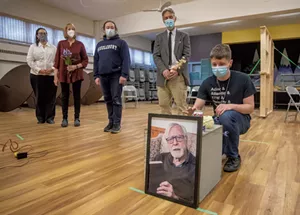
With masked faces, the cast and crew of the original musical comedy Halfway There circled up for rehearsal in a multipurpose room at Montpelier’s Bethany United Church of Christ. Set in a group home for people making the transition from inpatient psychiatric care to independent living, the show explores various states of mental well-being. With the team circled up around him, director and lead actor Peter Bowley relayed a grim message: With less than two weeks to go before the show’s opening, three cast members had contracted COVID-19. Though they were likely to recover by tech rehearsal the following week, their absence darkened the normally jubilant group. Then a cast member quipped, “Jim can do five roles at once,” referring to the show’s writer and composer, Jim Thompson. The tension evaporated. “You should see me in heels,” Thompson snapped back, crossing the room. After a good laugh, the group carried on with a run-through of the show’s second act. That split-second shift from seriousness to whimsy crystallized the essence of Halfway There. But the outbreak was ultimately no laughing matter. The scene described above took place in April, when the show was originally scheduled to premiere. Because the virus continued to rip through the cast and crew, the show was postponed until this Friday and Saturday, May 27 and 28, at the Barre Opera House. Thompson, 68, said the postponement was “only going to make the show that much better.” He pointed out that May is Mental Health Awareness Month, a happy coincidence. A longtime musician and educator, Thompson loosely based Halfway There on experiences that he had about 35 years ago while working at Plainfield’s Spruce Mountain Inn, a residential transitional living program. “[At first,] I was having trouble distinguishing between who were staff and who were clients,” he said during a video chat. In the show, new resident Claire (Erin Rathier-Bogart) initially mistakes fellow resident and love interest Max (Bowley) for a staffer. Her confusion, and Thompson’s, pose the question: What is “crazy,” a term used frequently in the show, and who gets to define it? The ensemble show features 16 actors who play characters confronting their demons amid family drama and romantic tension. At the center is anxious, agoraphobic Max and his journey toward independence. The show’s plot and dialogue explore themes of psychological trauma and the stigma surrounding it. The set is divided…
Original Musical 'Halfway There' Looks at Mental Illness in a New Light

